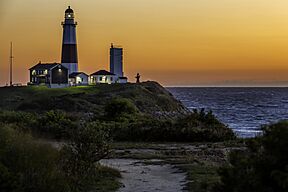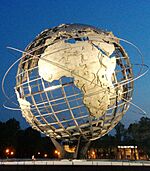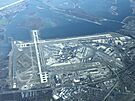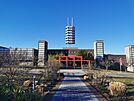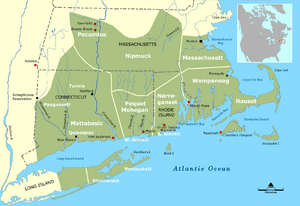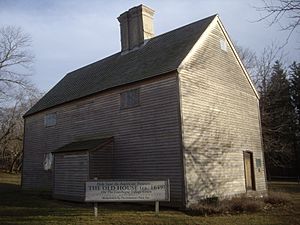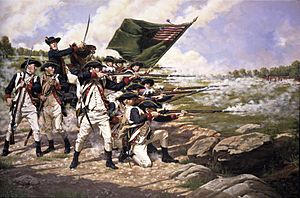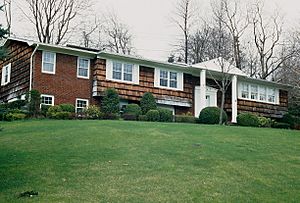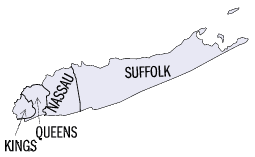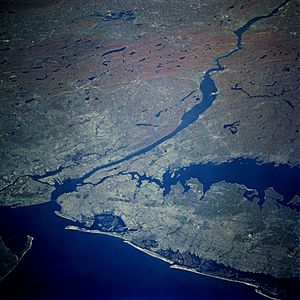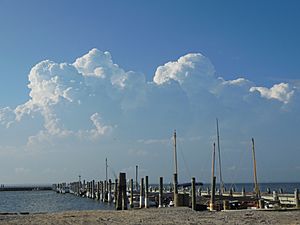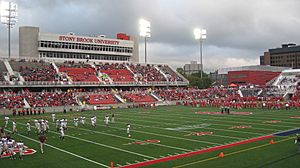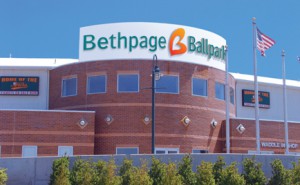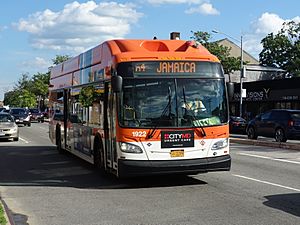Long Island facts for kids
|
Native name:
Paumanok
|
|
|---|---|
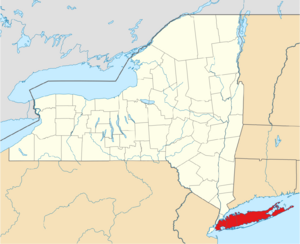
Location of Long Island in New York state
|
|
| Geography | |
| Location | Atlantic Ocean |
| Coordinates | 40°48′N 73°18′W / 40.8°N 73.3°W |
| Area | 1,376.1 sq mi (3,564 km2) |
| Highest elevation | 401 ft (122.2 m) |
| Highest point | Jayne's Hill |
| Administration | |
| State | New York |
| Largest settlement | Brooklyn, New York City (pop. 2,736,074) |
| Demographics | |
| Demonym | Long Islander |
| Population | 8,063,232 (2020) |
| Pop. density | 5,859.5 /sq mi (2,262.37 /km2) |
| Ethnic groups | 54.7% White, 20.5% Hispanic or Latino of any race, 20.4% Black, 12.3% Asian, 8.8% other races, 3.2% from two or more races, 0.49% Native American, and 0.05% Pacific Islander |
Long Island is a populous island east of Manhattan in southeastern New York state, constituting a significant share of the New York metropolitan area in both population and land area. The island extends from New York Harbor 118 miles (190 km) eastward into the North Atlantic Ocean with a maximum north–south width of 23 miles (37 km). With a land area of 1,401 square miles (3,630 km2), it is the largest island in the contiguous United States.
Long Island is divided among four counties, with Kings (Brooklyn), Queens, and Nassau counties occupying its western third and Suffolk County its eastern two-thirds. As of 2020, most New York City residents (58.4%) lived on Long Island in the outer boroughs of Brooklyn and Queens, although in common parlance, the term "Long Island", locally "the Island", refers exclusively to the counties of Nassau and Suffolk. Conversely, locally, the term "the City" refers to Manhattan alone. The Nassau–Suffolk-only definition of Long Island is recognized as a region by the State of New York. Although geographically an island, the Supreme Court of the United States has held that given the island's extensive ties to the mainland, it should be treated legally as a peninsula, giving the state jurisdiction over its maritime boundaries.
Long Island may refer both to the main island and the surrounding outer barrier islands. To its west, Long Island is separated from Manhattan and the Bronx by the East River tidal estuary. North of the island is Long Island Sound, across which lie Westchester County, New York, and the state of Connecticut. Across the Block Island Sound to the northeast is the state of Rhode Island. Block Island, which is part of Rhode Island, and numerous smaller islands extend farther into the Atlantic Ocean. To the extreme southwest, Long Island, at Brooklyn, is separated from Staten Island and the state of New Jersey by Upper New York Bay, The Narrows, and Lower New York Bay.
With a population of 8,063,232 residents as of the 2020 U.S. census, Long Island constitutes 40% of New York state's entire population. Long Island is the most populous island in any U.S. state or territory, the third-most populous island in the Americas after Hispaniola and Cuba, and the 18th-most populous island in the world ahead of Ireland, Jamaica, and Hokkaidō. Its population density is 5,859.5 inhabitants per square mile (2,262.4/km2). If Long Island geographically constituted an independent metropolitan statistical area, it would rank as the fourth-most populous in the United States; if it were a U.S. state, Long Island would rank as the 13th-most populous state and first in population density.
Long Island is culturally and ethnically diverse, featuring some of the wealthiest and most expensive neighborhoods in the world near the shorelines, as well as working-class areas in all four counties.
As of 2022, Kings, Queens, Nassau, and Suffolk counties collectively had a gross domestic product of approximately $500 billion. Median household income on the island significantly exceeds $100,000, and the median home price is approximately $600,000, with Nassau County approximating $700,000. Among residents over the age of 25, 42.6% hold a college degree or higher educational degree. Unemployment on Long Island stays consistently below 4%.
As a hub of commercial aviation, Long Island is home to two of the nation's and New York metropolitan area's busiest airports, JFK International Airport and LaGuardia Airport, both located in Queens. Also located on Long Island are Long Island MacArthur Airport in Ronkonkoma, and two major air traffic control radar facilities, New York TRACON and New York ARTCC.
Long Island has nine major bridges and thirteen navigable tunnels, which connect Brooklyn and Queens to the three other boroughs of New York City. Ferries connect Suffolk County northward across Long Island Sound to Connecticut. Long Island Rail Road is the busiest commuter railroad in North America and operates continuously.
Biotechnology companies, engineering, and scientific research play a significant role in Long Island's economy, including research facilities at Brookhaven National Laboratory, Cold Spring Harbor Laboratory, Stony Brook University, New York Institute of Technology, Plum Island Animal Disease Center, the New York University Tandon School of Engineering, the Zucker School of Medicine, and the Feinstein Institutes for Medical Research.
Contents
History
Early history
At the time of European contact, the Lenape people (named the Delaware by Europeans) inhabited the western end of Long Island, and spoke the Munsee dialect of Lenape, one of the Algonquian language family. Giovanni da Verrazzano was the first European to record an encounter with the Lenapes, after entering what is now New York Bay in 1524. The eastern portion of the island was inhabited by speakers of the Mohegan-Montauk-Narragansett language group of Algonquian languages; they were part of the Pequot and Narragansett peoples inhabiting the area that now includes Connecticut and Rhode Island.
In 1609, the English navigator Henry Hudson explored the harbor and purportedly landed at Coney Island. Adriaen Block followed in 1615 and is credited as the first European to determine that both Manhattan and Long Island are islands.
Native American land deeds recorded by the Dutch from 1636 state that the Indians referred to Long Island as Sewanhaka (Sewanhacky and Sewanhacking were other spellings in the transliteration of Lenape). Sewan was one of the terms for wampum (commemorative stringed shell beads, for a while also used as currency by colonists in trades with the Lenape), and is also translated as "loose" or "scattered", which may refer either to the wampum or to Long Island. The name " 't Lange Eylandt alias Matouwacs" (later shortened to "Lange Eylandt") appears in Dutch maps from the 1650s. Later, the English referred to the land as "Nassau Island", after the Dutch Prince William of Nassau, Prince of Orange (who later also ruled as King William III of England). It is unclear when the name "Nassau Island" was discontinued.
The very first settlements on Long Island were by settlers from England and its colonies in present-day New England. Lion Gardiner settled nearby Gardiners Island. The first settlement on the geographic Long Island itself was on October 21, 1640, when Southold was established by the Rev. John Youngs and settlers from New Haven, Connecticut. Peter Hallock, one of the settlers, drew the long straw and was granted the honor to step ashore first. He is considered the first New World settler on Long Island. Southampton was settled in the same year. Hempstead followed in 1644, East Hampton in 1648, Huntington in 1653, and Brookhaven in 1655.
While the eastern region of Long Island was first settled by the English, the western portion of Long Island was settled by the Dutch. Until 1664, the jurisdiction of Long Island was split, roughly at the present border between Nassau County and Suffolk County. The Dutch founded six towns in present-day Brooklyn beginning in 1645. These included: Brooklyn, Gravesend, Flatlands, Flatbush, New Utrecht, and Bushwick. The Dutch had granted an English settlement in Hempstead, New York (now in Nassau County) in 1644 but, after a boundary dispute, drove out English settlers from the Oyster Bay area. However, in 1664, the English returned to take over the Dutch colony of New Amsterdam, including Long Island.
The 1664 land patent granted to the Duke of York included all islands in Long Island Sound. The Duke of York held a grudge against Connecticut, as New Haven had hidden three of the judges who sentenced the Duke's father, King Charles I, to death in 1649. Settlers throughout Suffolk County pressed to stay part of Connecticut, but Governor Sir Edmund Andros threatened to eliminate the settlers' rights to land if they did not yield, which they did by 1676.
All of Long Island (as well as the islands between it and Connecticut) became part of the Province of New York within the Shire of York. Present-day Suffolk County was designated as the East Riding (of Yorkshire), present-day Brooklyn was part of the West Riding, and present-day Queens and Nassau were part of the larger North Riding. In 1683, Yorkshire was dissolved and the three original counties on Long Island were established: Kings, Queens, and Suffolk.
18th and 19th centuries
Early in the American Revolutionary War, the island was captured by the British from General George Washington in the Battle of Long Island, a decisive battle after which Washington narrowly evacuated his troops from Brooklyn Heights under a dense fog. After the British victory on Long Island, many Patriots fled, leaving mostly Loyalists behind. The island remained a British stronghold until the end of the war in 1783.
General Washington based his espionage activities on Long Island, due to the western part of the island's proximity to the British military headquarters in New York City. The Culper Spy Ring included agents operating between Setauket and Manhattan. This ring alerted Washington to valuable British secrets, including the treason of Benedict Arnold and a plan to use counterfeiting to induce economic sabotage.
Long Island's colonists served both Loyalist and Patriot causes, with many prominent families divided among both sides. During the occupation British troops used a number of civilian structures for defense and demanded to be quartered in the homes of civilians. A number of structures from this era remain. Among these are Raynham Hall, the Oyster Bay home of patriot spy Robert Townsend, and the Caroline Church in Setauket, which contains bullet holes from a skirmish known as the Battle of Setauket. Also in existence is a reconstruction of Brooklyn's Old Stone House, on the site of the Maryland 400's celebrated last stand during the Battle of Long Island.

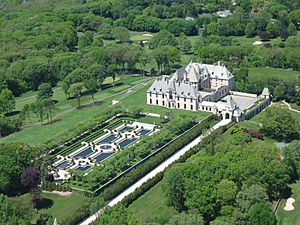
In the 19th century, Long Island was still mainly rural and devoted to agriculture. The predecessor to the Long Island Rail Road (LIRR) began service in 1836 from the South Ferry in Brooklyn, through the remainder of Brooklyn, to Jamaica in Queens. The line was completed to the east end of Long Island in 1844 (as part of a plan for transportation to Boston). Competing railroads (soon absorbed by the LIRR) were built along the south shore to accommodate travellers from those more populated areas. For the century from 1830 until 1930, total population roughly doubled every twenty years, with more dense development in areas near Manhattan. Several cities were incorporated, such as the City of Brooklyn in Kings County, and Long Island City in Queens.
Until the 1883 completion of the Brooklyn Bridge, the only connection between Long Island and the rest of the United States was by boat and ship. As other bridges and tunnels were constructed, areas of the island began to be developed as residential suburbs, first around the railroads that offered commuting into the city. On January 1, 1898, Kings County and portions of Queens were consolidated into The City of Greater New York, abolishing all cities and towns within them. The easternmost 280 square miles (730 km2) of Queens County, which were not part of the consolidation plan, separated from Queens in 1899 to form Nassau County.
At the close of the 19th century, wealthy industrialists who made vast fortunes during the Gilded Age began to construct large "baronial" country estates in Nassau County communities along the North Shore of Long Island, favoring the many properties with water views. Proximity to Manhattan attracted such men as J. P. Morgan, William K. Vanderbilt, and Charles Pratt, whose estates led to this area being nicknamed the Gold Coast. This period and the area was immortalized in fiction, such as F. Scott Fitzgerald's The Great Gatsby, which has also been adapted in films.
20th and 21st centuries
Charles Lindbergh lifted off from Roosevelt Field with his Spirit of Saint Louis for his historic 1927 solo flight to Europe, one of the events that helped to establish Long Island as an early center of aviation during the 20th Century. Other famous aviators such as Wiley Post originated notable flights from Floyd Bennett Field in Brooklyn, which became the first major airport serving New York City before it was superseded by the opening of La Guardia Airport in 1939. Long Island was also the site of Mitchel Air Force Base and was a major center of military aircraft production by companies such as Grumman and Fairchild Aircraft during World War II and for some decades afterward. Aircraft production on Long Island extended all the way into the Space Age – Grumman was one of the major contractors that helped to build the early lunar flight and space shuttle vehicles. Although the aircraft companies eventually ended their Long Island operations and the early airports were all later closed – Roosevelt Field, for instance, became the site of a major shopping mall – the Cradle of Aviation Museum on the site of the former Mitchel Field documents the Island's key role in the history of aviation.
From the 1920s to the 1940s, Long Island began the transformation from backwoods and farms as developers created numerous suburbs. Numerous branches of the LIRR already enabled commuting from the suburbs to Manhattan. Robert Moses engineered various automobile parkway projects to span the island, and developed beaches and state parks for the enjoyment of residents and visitors from the city. Gradually, development also followed these parkways, with various communities springing up along the more traveled routes.

After World War II, suburban development increased with incentives under the G.I. Bill, and Long Island's population skyrocketed, mostly in Nassau County and western Suffolk County. Second and third-generation children of immigrants moved out to eastern Long Island to settle in new housing developments built during the post-war boom. Levittown became noted as a suburb, where housing construction was simplified to be produced on a large scale. These provided opportunities for GIs returning home to buy houses and start a family.
The descendants of late 19th and early 20th-century immigrants from southern and eastern Europe, and black migrants from the South, have been followed by more recent immigrants from Asia and Latin America. Long Island has many ethnic Irish, Jews, and Italians, as well as an increasing numbers of Asians and Hispanics, reflecting later migrations.
In 1985, the United States Supreme Court ruled in United States v. Maine that Long Island was not an island for legal purposes.
By the start of the 21st century, a number of Long Island communities had successfully converted their assets from industrial uses to post-industrial roles. Brooklyn reversed decades of population decline and factory closings to resurface as a globally renowned cultural and intellectual hotbed. Gentrification has affected much of Brooklyn and a portion of Queens, relocating a sizeable swath of New York City's population. On eastern Long Island, such villages as Port Jefferson, Patchogue, and Riverhead have been changed from inactive shipbuilding and mill towns into tourist-centric commercial centers with cultural attractions.
Geography
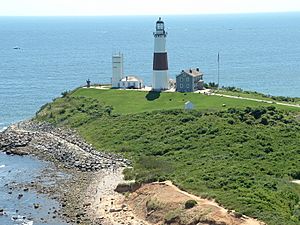
The westernmost end of Long Island contains the New York City boroughs of Brooklyn (Kings County) and Queens (Queens County). The central and eastern portions contain the suburban Nassau and Suffolk counties. However, colloquial usage of the term "Long Island" usually refers only to Nassau and Suffolk counties. For example, the Federal Reserve Bank of New York has a district named "Long Island (Nassau-Suffolk Metro Division)." At least as late as 1911, locations in Queens were still commonly referred to as being on Long Island. Some institutions in the New York City section of the island use the island's names, like Long Island University and Long Island Jewish Medical Center.
Nassau County is more densely developed than Suffolk County. While affluent overall, Nassau County has pockets of more pronounced wealth with estates covering greater acreage within the Gold Coast of the North Shore and the Five Towns area on the South Shore. South Shore communities are built along protected wetlands of the island and contain white sandy beaches of Outer Barrier Islands fronting on the Atlantic Ocean. Dutch and English settlers from the time before the American Revolutionary War, as well as communities of Native Americans, populated the island. The 19th century saw the infusion of the wealthiest Americans in the so-called Gold Coast of the North Shore, where wealthy Americans and Europeans in the Gilded Age built lavish country homes.
In its easternmost sections, Suffolk County remains semi-rural, as in Greenport on the North Fork and some of the periphery of the area prominently known as The Hamptons, although summer tourism swells the population in those areas. The North Fork peninsula of Suffolk County's East End has developed a burgeoning Wine Country region. In addition, the South Fork peninsula is known for beach communities, including the Hamptons, and for the Montauk Point Lighthouse at the eastern tip of the island. The Pine Barrens is a preserved pine forest encompassing much of eastern Suffolk County.
Geology
A detailed geomorphological study of Long Island provides evidence of glacial history of the kame and terminal moraines of the island which were formed by the advance and retreat of two ice sheets.
Long Island, as part of the Outer Lands region, is formed largely of two spines of glacial moraine, with a large, sandy outwash plain beyond. These moraines consist of gravel and loose rock left behind during the two most recent pulses of Wisconsin glaciation during the Ice Ages some 21,000 years ago (19,000 BC). The northern moraine, which directly abuts the North Shore of Long Island at points, is known as the Harbor Hill moraine. The more southerly moraine, known as the Ronkonkoma moraine, forms the "backbone" of Long Island; it runs primarily through the very center of Long Island, roughly coinciding with the length of the Long Island Expressway.
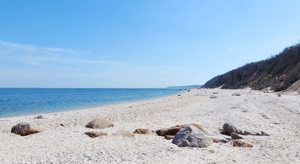
The land to the south of this moraine to the South Shore is the outwash plain of the last glacier. One part of the outwash plain was known as the Hempstead Plains, and this land contained one of the few natural prairies to exist east of the Appalachian Mountains.
The glaciers melted and receded to the north, resulting in the difference between the North Shore beaches and the South Shore beaches. The North Shore beaches are rocky from the remaining glacial debris, while the South Shore's are crisp, clear, outwash sand. Jayne's Hill, at 401 feet (122 m), within Suffolk County near its border with Nassau County, is the highest hill along either moraine; another well-known summit is Bald Hill in Brookhaven Town, not far from its geographical center at Middle Island. The glaciers also formed Lake Ronkonkoma in Suffolk County and Lake Success in Nassau County, each a deep kettle lake.
Countyscapes
-
Skyline of Long Island City, Queens
-
One Court Square. At a height of 658 feet, it is currently Long Island's tallest building.
-
A beach in The Hamptons of Suffolk County
Climate
Long Island has a climate similar to that of other coastal areas of the Northeastern United States; it has warm, humid summers and chilly, snowy winters with variable precipitation. Under the Köppen climate classification, the east of Long Island lies in a transition zone between a humid subtropical climate (Cfa) and a humid continental climate (Dfa). The oceanic climate zone (Cfb) only exists on the North Fork, the eastern end of the South Fork, islands in Peconic Bay, and Fishers Island, and is rare in eastern North America. Parts of the Harbor Hill Moraine are affected by a subtropical highland climate. The Atlantic Ocean brings afternoon sea breezes that temper the heat in the warmer months and limit the frequency and severity of thunderstorms. Long Island has a moderately sunny climate, averaging between 2,400 and 2,800 hours of sunshine annually.

Due to its coastal location, Long Island winter temperatures are significantly milder than most of the state. The coldest month is January, when average temperatures range from 30 to 35 °F (−1 to 2 °C), and the warmest month is July, when average temperatures range from 70 to 80 °F (21 to 27 °C). Temperatures seldom fall below 5 °F (−15 °C) or rise above 95 °F (35 °C). Long Island temperatures vary from west to east, with the western part (Nassau County, Queens, and Brooklyn) generally warmer than the east (Suffolk County). This is due to several factors: the western part is closer to the mainland and more densely developed, causing the "urban heat island" effect, and Long Island's land mass veers northward as one travels east. Also, daytime high temperatures on the eastern part of Long Island are cooler on most occasions due to moderation of the Atlantic Ocean and Long Island Sound. On dry nights with no clouds or wind, the Pine Barrens forest of eastern Suffolk County can be almost 20 degrees Fahrenheit (11 degrees Celsius) cooler than the rest of the island due to radiational cooling. Average dew points, a measure of atmospheric moisture, typically lie in the 60–70 °F (16–21 °C) range during July and August.
Precipitation is distributed fairly uniformly throughout the year, with approximately 3–4 inches (76–102 mm) on average during each month. Average yearly snowfall totals range from approximately 20 to 35 inches (51 to 89 cm), with the north shore and western parts averaging more than the south shore and the east end. In any given winter, however, some parts of the island could see up to 75 inches (190 cm) of snow or more. There are also some very quiet winters, in which most parts of the island could see less than 10 inches (25 cm) of snow.
On 13 August 2014, flash flooding occurred in western-central Suffolk County after a record-setting rainfall deposited more than three months' worth of precipitation on the area within a few hours.
Long Island is somewhat vulnerable to hurricanes. Its northern location (and the relatively cool waters around it) tend to weaken tropical cyclones before they reach its shores; nonetheless, several have stricken the Island as full hurricanes, including a devastating Category 3, the 1938 New England Hurricane (also known as the "Long Island Express"), and another Category 3, Hurricane Carol in 1954. Other 20th-century storms that made landfall on Long Island at hurricane intensity include the Great Atlantic Hurricane of 1944, Hurricane Donna in 1960, Hurricane Belle in 1976, and Hurricane Gloria in 1985. Also, the eyewall of Hurricane Bob in 1991 brushed the eastern tip. In August 2011, portions of Long Island were evacuated in preparation for Hurricane Irene, a Category 1 hurricane which weakened to a tropical storm before it reached Long Island.
On October 29, 2012, Hurricane Sandy caused extensive damage to low-lying coastal areas of Brooklyn, Queens, Nassau and Suffolk counties, destroying or severely damaging thousands of area homes and other structures by ocean and bay storm surges. Hundreds of thousands of residents were left without electric power for periods of time ranging up to several weeks while the damage was being repaired. The slow-moving "Superstorm Sandy" (so-nicknamed because its winds weakened below hurricane intensity as it made landfall) caused 90% of Long Island households to lose power and an estimated $18 billion in damages in Nassau & Suffolk Counties alone. The storm also had a devastating impact on coastal communities in the Brooklyn and Queens portions of the island, including Coney Island in Brooklyn and the Rockaway Peninsula in Queens, although estimates of monetary damages there are usually calculated as part of the overall losses suffered in New York City as a whole. The extent of Sandy's damages is second only to those caused by the 1938 Long Island Express, when adjusted for inflation. Although a lower central pressure was recorded in Sandy, the National Hurricane Center estimates that the 1938 hurricane had a lower pressure at landfall. Hurricane Sandy and its profound impacts have prompted the discussion of constructing seawalls and other coastal barriers around the shorelines of Long Island and New York City to minimize the risk of destructive consequences from another such event in the future.
| Climate data for Islip, New York (Long Island MacArthur Airport), 1981–2010 normals, extremes 1984–present | |||||||||||||
|---|---|---|---|---|---|---|---|---|---|---|---|---|---|
| Month | Jan | Feb | Mar | Apr | May | Jun | Jul | Aug | Sep | Oct | Nov | Dec | Year |
| Record high °F (°C) | 69 (21) |
67 (19) |
82 (28) |
94 (34) |
98 (37) |
96 (36) |
102 (39) |
100 (38) |
93 (34) |
88 (31) |
78 (26) |
77 (25) |
102 (39) |
| Mean daily maximum °F (°C) | 38.0 (3.3) |
40.3 (4.6) |
47.3 (8.5) |
57.6 (14.2) |
67.5 (19.7) |
76.6 (24.8) |
81.7 (27.6) |
80.4 (26.9) |
73.8 (23.2) |
63.0 (17.2) |
53.2 (11.8) |
43.0 (6.1) |
60.3 (15.7) |
| Mean daily minimum °F (°C) | 23.3 (−4.8) |
25.2 (−3.8) |
31.3 (−0.4) |
40.6 (4.8) |
49.8 (9.9) |
60.2 (15.7) |
66.0 (18.9) |
65.3 (18.5) |
57.5 (14.2) |
45.5 (7.5) |
37.1 (2.8) |
28.2 (−2.1) |
44.3 (6.8) |
| Record low °F (°C) | −7 (−22) |
0 (−18) |
5 (−15) |
23 (−5) |
32 (0) |
42 (6) |
50 (10) |
45 (7) |
38 (3) |
28 (−2) |
11 (−12) |
5 (−15) |
−7 (−22) |
| Average precipitation inches (mm) | 3.64 (92) |
3.26 (83) |
4.44 (113) |
4.34 (110) |
3.78 (96) |
4.27 (108) |
3.43 (87) |
3.98 (101) |
3.58 (91) |
3.79 (96) |
3.67 (93) |
4.06 (103) |
46.24 (1,173) |
| Average snowfall inches (cm) | 6.7 (17) |
7.1 (18) |
4.5 (11) |
0.6 (1.5) |
0 (0) |
0 (0) |
0 (0) |
0 (0) |
0 (0) |
0 (0) |
0.5 (1.3) |
5.4 (14) |
24.8 (62.8) |
| Average precipitation days (≥ 0.01 in) | 11.0 | 9.1 | 10.5 | 11.3 | 11.1 | 10.1 | 9.1 | 8.5 | 8.6 | 8.5 | 10.3 | 10.8 | 118.9 |
| Average snowy days (≥ 0.1 in) | 3.7 | 3.4 | 2.3 | 0.3 | 0 | 0 | 0 | 0 | 0 | 0 | 0.2 | 2.4 | 12.3 |
| Source: NOAA | |||||||||||||
| Climate data for LaGuardia Airport, New York (1981–2010 normals, extremes 1940–present) | |||||||||||||
|---|---|---|---|---|---|---|---|---|---|---|---|---|---|
| Month | Jan | Feb | Mar | Apr | May | Jun | Jul | Aug | Sep | Oct | Nov | Dec | Year |
| Record high °F (°C) | 72 (22) |
74 (23) |
86 (30) |
94 (34) |
97 (36) |
101 (38) |
107 (42) |
104 (40) |
102 (39) |
93 (34) |
83 (28) |
75 (24) |
107 (42) |
| Mean maximum °F (°C) | 58.6 (14.8) |
60.1 (15.6) |
70.5 (21.4) |
81.2 (27.3) |
88.5 (31.4) |
93.4 (34.1) |
96.6 (35.9) |
94.4 (34.7) |
88.8 (31.6) |
79.7 (26.5) |
71.1 (21.7) |
62.1 (16.7) |
98.1 (36.7) |
| Mean daily maximum °F (°C) | 39.3 (4.1) |
42.2 (5.7) |
49.8 (9.9) |
60.9 (16.1) |
71.2 (21.8) |
80.5 (26.9) |
85.3 (29.6) |
83.7 (28.7) |
76.3 (24.6) |
65.2 (18.4) |
54.7 (12.6) |
44.3 (6.8) |
62.9 (17.2) |
| Mean daily minimum °F (°C) | 26.6 (−3.0) |
28.5 (−1.9) |
34.6 (1.4) |
44.4 (6.9) |
53.9 (12.2) |
63.8 (17.7) |
69.5 (20.8) |
68.9 (20.5) |
61.9 (16.6) |
51.0 (10.6) |
41.8 (5.4) |
32.1 (0.1) |
48.2 (9.0) |
| Mean minimum °F (°C) | 10.0 (−12.2) |
13.5 (−10.3) |
19.7 (−6.8) |
33.8 (1.0) |
45.2 (7.3) |
54.1 (12.3) |
62.0 (16.7) |
60.4 (15.8) |
50.9 (10.5) |
39.9 (4.4) |
29.3 (−1.5) |
16.6 (−8.6) |
7.5 (−13.6) |
| Record low °F (°C) | −3 (−19) |
−7 (−22) |
7 (−14) |
22 (−6) |
37 (3) |
46 (8) |
56 (13) |
51 (11) |
41 (5) |
30 (−1) |
17 (−8) |
−2 (−19) |
−7 (−22) |
| Average precipitation inches (mm) | 3.17 (81) |
2.76 (70) |
3.97 (101) |
4.00 (102) |
3.79 (96) |
3.94 (100) |
4.50 (114) |
4.12 (105) |
3.73 (95) |
3.78 (96) |
3.41 (87) |
3.56 (90) |
44.73 (1,136) |
| Average snowfall inches (cm) | 7.4 (19) |
9.1 (23) |
4.4 (11) |
0.5 (1.3) |
0 (0) |
0 (0) |
0 (0) |
0 (0) |
0 (0) |
0 (0) |
0.3 (0.76) |
5.2 (13) |
26.9 (68.06) |
| Average precipitation days (≥ 0.01 inch) | 10.3 | 9.6 | 10.7 | 10.9 | 11.1 | 10.5 | 9.9 | 8.7 | 8.1 | 8.5 | 9.2 | 10.5 | 118.0 |
| Average snowy days (≥ 0.1 inch) | 4.6 | 3.4 | 2.1 | 0.2 | 0 | 0 | 0 | 0 | 0 | 0 | 0.2 | 2.6 | 13.1 |
| Average relative humidity (%) | 61.0 | 60.2 | 59.5 | 59.3 | 63.8 | 64.6 | 64.7 | 67.0 | 67.2 | 65.2 | 64.2 | 63.5 | 63.4 |
| Source: NOAA (relative humidity 1961–1990) | |||||||||||||
| Climate data for JFK Airport, New York (1981–2010 normals, extremes 1948–present) | |||||||||||||
|---|---|---|---|---|---|---|---|---|---|---|---|---|---|
| Month | Jan | Feb | Mar | Apr | May | Jun | Jul | Aug | Sep | Oct | Nov | Dec | Year |
| Record high °F (°C) | 71 (22) |
71 (22) |
85 (29) |
90 (32) |
99 (37) |
99 (37) |
104 (40) |
101 (38) |
98 (37) |
90 (32) |
77 (25) |
75 (24) |
104 (40) |
| Mean maximum °F (°C) | 56.8 (13.8) |
57.9 (14.4) |
68.5 (20.3) |
78.1 (25.6) |
84.9 (29.4) |
92.1 (33.4) |
94.5 (34.7) |
92.7 (33.7) |
87.4 (30.8) |
78.0 (25.6) |
69.1 (20.6) |
60.1 (15.6) |
96.6 (35.9) |
| Mean daily maximum °F (°C) | 39.1 (3.9) |
41.8 (5.4) |
49.0 (9.4) |
59.0 (15.0) |
68.5 (20.3) |
78.0 (25.6) |
83.2 (28.4) |
81.9 (27.7) |
75.3 (24.1) |
64.5 (18.1) |
54.3 (12.4) |
44.0 (6.7) |
61.6 (16.4) |
| Mean daily minimum °F (°C) | 26.3 (−3.2) |
28.1 (−2.2) |
34.2 (1.2) |
43.5 (6.4) |
52.8 (11.6) |
62.8 (17.1) |
68.5 (20.3) |
67.8 (19.9) |
60.8 (16.0) |
49.6 (9.8) |
40.7 (4.8) |
31.5 (−0.3) |
47.3 (8.5) |
| Mean minimum °F (°C) | 9.8 (−12.3) |
13.4 (−10.3) |
19.1 (−7.2) |
32.6 (0.3) |
42.6 (5.9) |
52.7 (11.5) |
60.7 (15.9) |
58.6 (14.8) |
49.2 (9.6) |
37.6 (3.1) |
27.4 (−2.6) |
16.3 (−8.7) |
7.5 (−13.6) |
| Record low °F (°C) | −2 (−19) |
−2 (−19) |
4 (−16) |
20 (−7) |
34 (1) |
45 (7) |
55 (13) |
46 (8) |
40 (4) |
30 (−1) |
19 (−7) |
2 (−17) |
−2 (−19) |
| Average precipitation inches (mm) | 3.16 (80) |
2.59 (66) |
3.78 (96) |
3.87 (98) |
3.94 (100) |
3.86 (98) |
4.08 (104) |
3.68 (93) |
3.50 (89) |
3.62 (92) |
3.30 (84) |
3.39 (86) |
42.77 (1,086) |
| Average snowfall inches (cm) | 6.3 (16) |
8.3 (21) |
3.5 (8.9) |
0.8 (2.0) |
0 (0) |
0 (0) |
0 (0) |
0 (0) |
0 (0) |
0 (0) |
0.2 (0.51) |
4.7 (12) |
23.8 (60) |
| Average precipitation days (≥ 0.01 inch) | 10.5 | 9.6 | 11.0 | 11.4 | 11.5 | 10.7 | 9.4 | 8.7 | 8.1 | 8.5 | 9.4 | 10.6 | 119.4 |
| Average snowy days (≥ 0.1 inch) | 4.6 | 3.4 | 2.3 | 0.3 | 0 | 0 | 0 | 0 | 0 | 0 | 0.2 | 2.8 | 13.6 |
| Average relative humidity (%) | 64.9 | 64.4 | 63.4 | 64.1 | 69.5 | 71.5 | 71.4 | 71.7 | 71.9 | 69.1 | 67.9 | 66.3 | 68.0 |
| Source: NOAA (relative humidity 1961–1990) | |||||||||||||
Additional islands
Several smaller islands, though geographically distinct, are in proximity to Long Island and are often grouped with it. These islands include Fire Island, the largest of the outer barrier islands that parallels the southern shore of Long Island for approximately 31 miles; Plum Island, which is home to the Plum Island Animal Disease Center, a biological weapons research facility; as well as Robins Island, Gardiners Island, Fishers Island, Long Beach Barrier Island, Jones Beach Island, and Shelter Island.
Demographics
Long Island is the most populous island and one of the most densely populated regions in the United States. At the 2020 U.S. census, the total population of all four counties of Long Island was 8,063,232, comprising 40% of the population of the State of New York. As of 2020, the proportion of New York City residents (total 8,804,190) living on Long Island had risen to 58.4%, given the 5,141,538 residents living in Brooklyn and Queens. Furthermore, the proportion of New York State's population residing on Long Island has also been increasing, with Long Island's census-estimated population increasing 6.5% since 2010, to 8,063,232 in 2020, representing 40% of New York State's census 2020-enumerated population of 20,215,751 and with a population density of 5,859.5 inhabitants per square mile (2,262.4/km2) on Long Island; the island is more populous than 37 of the 50 U.S. states.
At the 2020 census, the combined population of Nassau and Suffolk counties was 2,921,694 people, Suffolk County's share being 1,525,920 and Nassau County's 1,395,774. Nassau County had a larger population for decades, but Suffolk County surpassed it in the 1990 census as growth and development continued to spread eastward. As Suffolk County has more than three times the land area of Nassau County, the latter still has a much higher population density, given its proximity to New York City. According to the U.S. Census Bureau's 2008 American Community Survey, Nassau and Suffolk counties had the 10th and 26th highest median household incomes in the nation, respectively. Long Island's population is in decline, having lost over 111,000 residents to other states between 2017 and 2022. An exception was in 2020 during the pandemic, when Long Island saw a small net increase as city residents left for more space. Those who leave Long Island are generally younger than the median resident and less likely to have a four-year degree, children, or high income. Florida, Pennsylvania, and North Carolina are the biggest recipients of ex-Long Islanders. The Island has seen a net increase from New Yorkers leaving other parts of the state, and a net decrease of Long Islanders leaving for other areas in New York.
| Historical population | |||
|---|---|---|---|
| Census | Pop. | %± | |
| 1790 | 37,108 | — | |
| 1800 | 42,907 | 15.6% | |
| 1810 | 48,752 | 13.6% | |
| 1820 | 56,978 | 16.9% | |
| 1830 | 69,775 | 22.5% | |
| 1840 | 110,406 | 58.2% | |
| 1850 | 212,637 | 92.6% | |
| 1860 | 379,788 | 78.6% | |
| 1870 | 540,648 | 42.4% | |
| 1880 | 743,957 | 37.6% | |
| 1890 | 1,029,097 | 38.3% | |
| 1900 | 1,452,611 | 41.2% | |
| 1910 | 2,098,460 | 44.5% | |
| 1920 | 2,723,764 | 29.8% | |
| 1930 | 4,103,638 | 50.7% | |
| 1940 | 4,600,022 | 12.1% | |
| 1950 | 5,237,918 | 13.9% | |
| 1960 | 6,403,852 | 22.3% | |
| 1970 | 7,141,515 | 11.5% | |
| 1980 | 6,728,074 | −5.8% | |
| 1990 | 6,861,474 | 2.0% | |
| 2000 | 7,448,618 | 8.6% | |
| 2010 | 7,568,304 | 1.6% | |
| 2020 | 8,063,232 | 6.5% | |
Whites are the largest racial group in all four counties, and are in the majority in Nassau and Suffolk counties. In 2002, The New York Times cited a study by the non-profit group ERASE Racism, which determined that Nassau and Suffolk counties constitute the most racially segregated suburbs in the United States.
In contrast, Queens is the most ethnically diverse county in the United States and the most diverse urban area in the world.
According to a 2000 report on religion, which asked congregations to respond, Catholics are the largest religious group on Long Island, with non-affiliated in second place. Catholics make up 52% of the population of Nassau and Suffolk, versus 22% for the country as a whole, with Jews at 16% and 7%, respectively, versus 1.7% nationwide. Only a small percentage of Protestants responded, 7% and 8% respectively, for Nassau and Suffolk counties. This is in contrast with 23% for the entire country on the same survey, and 50% on self-identification surveys.
A growing population of nearly half a million Chinese Americans now live on Long Island. Rapidly expanding Chinatowns have developed in Brooklyn and Queens, with Chinese immigrants also moving into Nassau County, as did earlier European immigrants, such as the Irish and Italians. The busy intersection of Main Street, Kissena Boulevard, and 41st Avenue defines the center of Downtown Flushing and the Flushing Chinatown, known as the "Chinese Times Square" or the "Chinese Manhattan". The segment of Main Street between Kissena Boulevard and Roosevelt Avenue, punctuated by the Long Island Rail Road trestle overpass, represents the cultural heart of the Flushing Chinatown. Housing over 30,000 individuals born in China alone, the largest by this metric outside Asia, Flushing has become home to the largest and one of the fastest-growing Chinatowns in the world as the heart of over 250,000 ethnic Chinese in Queens, representing the largest Chinese population of any U.S. municipality other than New York City in total. ..... Flushing is undergoing rapid gentrification with investment by Chinese transnational entities.
More recently, a Little India community has emerged in Hicksville, Nassau County, spreading eastward from the more established Little India enclaves in Queens. Rapidly growing Chinatowns have developed in Brooklyn and Queens, as did earlier European immigrants, such as the Irish and Italians. As of 2019, the Asian population in Nassau County had grown by 39% since 2010 to an estimated 145,191 individuals, including approximately 50,000 Indian Americans and 40,000 Chinese Americans, as Nassau County has become the leading suburban destination in the U.S. for Chinese immigrants. Likewise, the Long Island Koreatown originated in Flushing, Queens, and is expanding eastward along Northern Boulevard and into Nassau County.
Long Island is home to two Native American reservations, Poospatuck Reservation, and Shinnecock Reservation, both in Suffolk County. Numerous island place names are Native American in origin.
A 2010 article in The New York Times stated that the expansion of the immigrant workforce on Long Island has not displaced any jobs from other Long Island residents. Half of the immigrants on Long Island hold white-collar positions.
The counties of Nassau and Suffolk have been long renowned for their affluence. Long Island is home to some of the wealthiest communities in the United States, including The Hamptons, on the East End of the South Shore of Suffolk County; the Gold Coast, in the vicinity of the island's North Shore, along Long Island Sound; and increasingly, the western shoreline of Brooklyn, facing Manhattan. In 2016, according to Business Insider, the 11962 zip code encompassing Sagaponack, within Southampton, was listed as the most expensive in the U.S., with a median home sale price of $8.5 million.
Economy

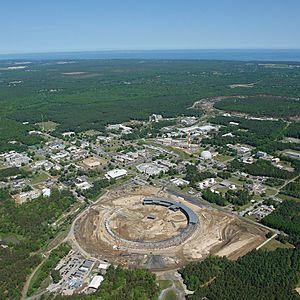
Long Island has played a prominent role in scientific research and in engineering. It is the home of the Brookhaven National Laboratory in nuclear physics and Department of Energy research. Long Island is also home to the Cold Spring Harbor Laboratory, which was directed for 35 years by James D. Watson (who, along with Francis Crick and Rosalind Franklin, discovered the double helix structure of DNA). Companies such as Sperry Corporation, Computer Associates (headquartered in Islandia), Zebra Technologies (now occupying the former headquarters of Symbol Technologies, and a former Grumman plant in Holtsville), have made Long Island a center for the computer industry. Stony Brook University and New York Institute of Technology conduct advanced medical and technological research.
Long Island is home to the East Coast's largest industrial park, the Hauppauge Industrial Park, hosting over 1,300 companies which employ more than 71,000 individuals. Companies in the park and abroad are represented by the Hauppauge Industrial Association. As many as 20% of Long Islanders commute to jobs in Manhattan. The island's eastern end is still partly agricultural. Development of vineyards on the North Fork has spawned a major viticultural industry, replacing potato fields. Pumpkin farms have been added to traditional truck farming. Farms allow fresh fruit picking by Long Islanders for much of the year. Fishing continues to be an important industry, especially at Huntington, Northport, Montauk, and other coastal communities of the East End and South Shore.
From about 1930 to about 1990, Long Island was considered one of the aerospace manufacturing centers of the United States, with companies such as Grumman, Republic, Fairchild, and Curtiss having their headquarters and factories on Long Island. These operations have largely been phased out or significantly diminished.
Education
Primary and secondary education

Many public and private high schools on Long Island are ranked among the best in the United States. Nassau and Suffolk counties are the home of 125 public school districts containing 656 public schools. Brookhaven Public Schools is the largest district. It also hosts private schools such as Friends Academy, Chaminade High School, Kellenberg Memorial High School, St. Anthony's High School, and North Shore Hebrew Academy. There also are many parochial schools on Long Island, including several operated by the Catholic] Diocese of Rockville Centre.
In contrast, all of Brooklyn and Queens are served by the New York City Department of Education, the largest school district in the United States. Three of the nine specialized high schools in New York City are in the two Long Island boroughs, those being Brooklyn Latin School, Brooklyn Technical High School (one of the original three specialized schools), and Queens High School for the Sciences. Like Nassau and Suffolk counties, they are home to private schools such as Poly Prep Country Day School, Packer Collegiate Institute, and Saint Ann's School, and Berkeley Carroll School, and parochial schools operated by the Catholic Diocese of Brooklyn.
Colleges and universities
Long Island is home to a range of higher education institutions, both public and private. Brooklyn and Queens contain five of eleven senior colleges within CUNY, the public university system of New York City and one of the largest in the country. Among these are the notable institutions of Brooklyn College and Queens College. Brooklyn also contains private colleges such as Pratt Institute and the New York University Tandon School of Engineering, the engineering school of New York University.
Several colleges and universities within the State University of New York system are on Long Island, including Stony Brook University, Nassau Community College, and Suffolk County Community College. Notable private universities on Long Island include Molloy University in Rockville Centre, the New York Institute of Technology in Old Westbury, Hofstra University and Adelphi University (both in Hempstead), Long Island University (with its C.W. Post campus on a former Gold Coast estate in Brookville and a satellite campus in downtown Brooklyn, the Webb Institute, a small naval architecture college in Glen Cove, and the U.S. Merchant Marine Academy, a U.S. service academy in Kings Point, on the North Shore.
Culture
Music
Music on Long Island (Nassau and Suffolk) is strongly influenced by the proximity to New York City and by the youth culture of the suburbs. Psychedelic rock was widely popular in the 1960s as flocks of disaffected youth travelled to NYC to participate in protest and the culture of the time. Rhythm and blues also has a history on Long Island, most notably Huntington-born Mariah Carey, one of the top-selling musicians of all time. In the late 1970s through the 1980s, the influence of radio station WLIR made Long Island one of the first places in the nation to hear and embrace European New Wave bands, including Depeche Mode, Pet Shop Boys, and Culture Club. In the 1990s, hip hop music became popular. Rap pioneers Rakim, EPMD, De La Soul, MF Doom, and Public Enemy grew up on Long Island. Long Island was the home of a bustling emo scene in the 2000s, with bands such as Brand New, Taking Back Sunday, Straylight Run, From Autumn to Ashes and As Tall as Lions. Rock bands from Long Island include the Rascals, the Ramones (from Queens), Dream Theater, Blue Öyster Cult, Twisted Sister, and guitar virtuosos Donald (Buck Dharma) Roeser, John Petrucci, Steve Vai, and Joe Satriani, and drummer Mike Portnoy. Rock and pop singer Billy Joel grew up in Hicksville, and his music references Long Island and his youth.
Nassau Coliseum and Jones Beach Theater are venues used by national touring acts as performance spaces for concerts. Jones Beach Theater is a popular place to view summer concerts that feature new and classic artists. It also hosts a large Fourth of July fireworks show annually.
Long Island is also known for its school music programs. Many schools in both Nassau and Suffolk County have distinguished music programs, with high numbers of students who are accepted into the statewide All-State music groups, or even the National All-Eastern Coast music groups. Both the Suffolk County and Nassau County Music Educator's Associations are recognized by The National Association for Music Education (NAfME), and host numerous events, competitions, and other music-related activities.
Cuisine
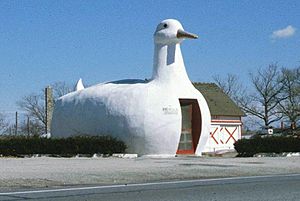
Long Island has historically been a center for fishing and seafood. This legacy continues in the Blue Point oyster, a now ubiquitous variety that was originally harvested on the Great South Bay and was the favorite oyster of Queen Victoria. Clams are also a popular food and clam digging a popular recreational pursuit, with Manhattan clam chowder reputed to have Long Island origins.
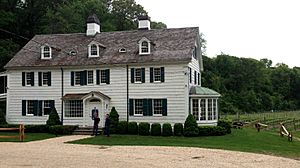
Of land-based produce, Long Island duck has a history of national recognition since the 19th century, with four duck farms continuing to produce 2 million ducks a year as of 2013[update]. Two symbols of Long Island's duck farming heritage are the Long Island Ducks minor-league baseball team and the Big Duck, a 1931 duck-shaped building that is a historic landmark and tourist attraction. In addition to Long Island's duck industry, Riverhead contains one of the largest buffalo farms on the East coast.
Long Island is well known for its production of alcoholic beverages. Eastern Long Island is a significant producer of wines. Vineyards are most heavily concentrated on Long Island's North Fork, which contains 38 wineries. Most of these contain tasting rooms, which serve as popular tourist attractions for visitors from across the New York metropolitan area. Long Island has also become a producer of diverse craft beers, with 15 microbreweries existing across Nassau and Suffolk counties as of 2013[update]. The largest of these is Blue Point Brewing Company, best known for its toasted lager. Long Island is also globally known for its signature cocktail, the Long Island Iced Tea, which purportedly was invented at the popular Babylon, Oak Beach Inn nightclub in the 1970s.
The eateries on Long Island are largely a product of the region's local ethnic populations. Italian cuisine is represented by ubiquitous pizzerias spread throughout the island, with the region hosting an annual competition, the Long Island Pizza Festival & Bake-Off. Jewish cuisine is likewise represented by delicatessens and bagel stores.
Sports
Major league sports
The New York Mets of Major League Baseball play at Citi Field in Flushing Meadows-Corona Park, Queens. Their former stadium, Shea Stadium, was also home for the New York Jets of the National Football League from 1964 until 1983. The new stadium has an exterior façade and main entry rotunda inspired by Brooklyn's famous Ebbets Field.
The Barclays Center, a sports arena, business, and residential complex built partly on a platform over the Atlantic Yards at Atlantic Avenue in Brooklyn, is the home of the Brooklyn Nets and New York Liberty basketball teams. The move from New Jersey in the summer of 2012 marked the return to Long Island for the Nets franchise, which played at Nassau Veterans Memorial Coliseum in Uniondale from 1972 to 1977. The New York Islanders hockey team played at Nassau Coliseum from their 1972 inception through 2015, and then splitting time between Nassau Coliseum and Barclays Center from 2017 to 2021, playing their last full season at the Nassau Coliseum during the 2020-2021 NHL Season. The Islanders moved full-time to UBS Arena at Belmont Park, in Elmont, New York, in November 2021.
Historical professional teams
Ebbets Field, which stood in Brooklyn from 1913 until its demolition in 1960, was the home of the Brooklyn Dodgers baseball team, who moved to Los Angeles after the 1957 Major League Baseball season to become the Los Angeles Dodgers. The Dodgers won several National League pennants in the 1940s and 1950s, losing several times in the World Series, often called the Subway Series, to their Bronx rivals, the New York Yankees. The Dodgers won their lone championship in Brooklyn in the 1955 World Series versus the Yankees.
Despite this success during the latter part of the team's stay in Brooklyn, they were a second-division team with an unspectacular winning record for much of their history there – but nonetheless became legendary for the almost-fanatical devotion of the Brooklynites who packed the relatively small ballpark to vigorously root for the team they affectionately called, "Dem Bums". Loss of the Dodgers to California was locally considered a civic tragedy that negatively affected the community far more than the similar moves of other established teams to new cities in the 1950s, including the Dodgers' long-time arch-rival New York Giants, who also left for California after 1957.
Minor league sports
Long Island is home to the Long Island Ducks independent league team of the Atlantic League. Their stadium, Bethpage Ballpark, is in Central Islip. The Brooklyn Cyclones minor league baseball team, affiliated with the New York Mets, plays in the High-A classification South Atlantic League. The Cyclones play at MCU Park just off the Coney Island Boardwalk in the New York City borough of Brooklyn. The New York Dragons of the Arena Football League played their home games at Nassau Coliseum. The two main rugby union teams are the Long Island RFC in East Meadow and the Suffolk Bull Moose in Stony Brook.
The Brooklyn Cyclones are a minor league baseball team, affiliated with the New York Mets. The Cyclones play at MCU Park just off the boardwalk on Coney Island in Brooklyn. An artificial turf baseball complex named Baseball Heaven is in Yaphank.
The New York Sharks is a women's American football team that is a member of the Women's Football Alliance. The New York Sharks home field is at Aviator Sports Complex in Brooklyn. The New York Mets planned to move their Double-A farm team to Long Island, as part of the ambitious but now-defunct plan for Nassau County called The Lighthouse Project.
Long Island's professional soccer club, the New York Cosmos, play in the Division 2 North American Soccer League at James M. Shuart Stadium in Hempstead.
Long Island has historically been a hotbed of lacrosse at the youth and college level, which made way for a Major League Lacrosse team in 2001, the Long Island Lizards. The Lizards play at Mitchel Athletic Complex in Uniondale.
Collegiate sports
The Stony Brook Seawolves represent Stony Brook University, and have had a bevy of athletic accomplishments such as reaching the 2012 College World Series as an underdog after defeating the LSU Tigers in a best-of-3 series.
Other sports

Long Island has a wide variety of golf courses found all over the island. Two of the most well-known are the Shinnecock Hills Golf Club and the public Bethpage Black Course that has hosted multiple U.S. Open tournaments and several other top level international championships. Queens also hosts one of the four tennis grand slams, the US Open. Every August (September, in Olympic years) the best tennis players in the world travel to Long Island to play the championships held at the USTA Billie Jean King National Tennis Center, adjacent to Citi Field in Flushing Meadows Park. The complex also contains the biggest tennis stadium in the world, the Arthur Ashe Stadium.
Long Island also has two horse racing tracks, Aqueduct Racetrack in Ozone Park, Queens and Belmont Park on the Queens/Nassau border in Elmont, home of the Belmont Stakes. The longest dirt thoroughbred racecourse in the world is also at Belmont Park. Another category of sporting events popular in this region involves firematic racing events, involving many local volunteer fire departments.
Notable sports teams
| Club | City | Sport | Founded | League | Venue(s) | Championships |
|---|---|---|---|---|---|---|
| Brooklyn Nets | Brooklyn | Basketball | 1967 | National Basketball Association | Barclays Center | 2 (1974, 1976) |
| New York Islanders | Elmont | Ice hockey | 1972 | National Hockey League | UBS Arena | 4 (1980, 1981, 1982, 1983) |
| New York Mets | Queens | Baseball | 1962 | Major League Baseball | Citi Field | 2 (1969, 1986) |
| Brooklyn Cyclones | Brooklyn | Baseball | 1986 | South Atlantic League | Maimonides Park | 2 (1986, 2001) |
| Long Island Nets | Uniondale | Basketball | 2015 | NBA G League | Nassau Veterans Memorial Coliseum | 0 |
| Long Island Ducks | Islip | Baseball | 2000 | Atlantic League | Fairfield Properties Ballpark | 4 (2004, 2012, 2013, 2019) |
Transportation

Many major forms of transportation serve Long Island, including aviation via John F. Kennedy International Airport, LaGuardia Airport, and Long Island MacArthur Airport, and multiple smaller airports; rail transportation via the Long Island Rail Road and the New York City Subway; bus routes via MTA Regional Bus Operations, Nassau Inter-County Express, and Suffolk County Transit; ferry service via NYC Ferry and multiple smaller ferry companies; and several major highways. There are historic and modern bridges, and recreational and commuter trails, serving various parts of Long Island.
There are eleven road crossings out of Long Island, all but one providing Brooklyn-Manhattan, Queens-Manhattan, and Queens-Bronx connections across the East River, with the Triborough Bridge providing two connections from Queens, one each to Manhattan and the Bronx. The single non-East River crossing is the Verrazzano-Narrows Bridge, connecting Brooklyn to Staten Island across The Narrows. Plans for a Long Island Sound link at locations in Nassau and Suffolk counties (a proposed bridge or tunnel that would link Long Island to the south with Westchester County, New York or Connecticut to the north across Long Island Sound) have been discussed for decades, but there are no plans to construct such a crossing.
Public transportation
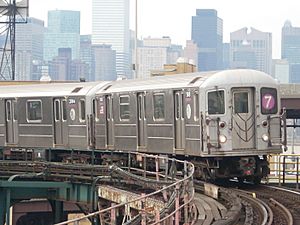
The Metropolitan Transportation Authority operates mass transportation for the New York metropolitan area including all five boroughs of New York City, the suburban counties of Dutchess, Nassau, Orange, Putnam, Rockland, Suffolk, and Westchester, all of which together are the "Metropolitan Commuter Transportation District (MCTD)".
The MTA considers itself to be the largest regional public transportation provider in the Western Hemisphere. As of 2018[update], MTA agencies move about 8.6 million customers per day (translating to 2.65 billion rail and bus customers a year). The MTA's systems carry over 11 million passengers on an average weekday systemwide, and over 850,000 vehicles on its seven toll bridges and two tunnels per weekday.
Rail
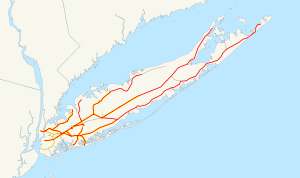
The Long Island Rail Road (LIRR) is North America's busiest commuter railroad system, carrying an average of 282,400 passengers each weekday on 728 daily trains. Chartered on April 24, 1834, and operating continuously since, it is also the oldest railroad in the U.S. that still operates under its original charter and name. The Metropolitan Transportation Authority has operated the LIRR as one of its two commuter railroads since 1966, and the LIRR is one of the few railroads worldwide that provides service all the time, year round. A $2 billion plan to add a third railroad track to the LIRR Main Line between the Floral Park and Hicksville stations in Nassau County was completed in 2022, and an expansion of the Ronkonkoma Branch from one to two tracks was completed in 2018. Five "readiness projects" across the LIRR system, which cost a combined $495 million, were built in preparation for expanded peak-hour LIRR service after the completion of East Side Access, which brings LIRR trains to Grand Central Madison in Manhattan.
Bus
Nassau Inter-County Express (NICE) provides bus service in Nassau County, while Suffolk County Transit, an agency of the Suffolk County government, provides bus service in Suffolk County. In 2012, NICE replaced the former MTA's Long Island Bus in transporting Long Islanders across Nassau County while allowing them to use MTA MetroCards as payment.
Roads
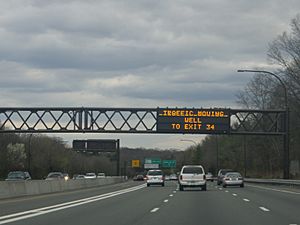
The Long Island Expressway, Northern State Parkway, and Southern State Parkway, all products of the automobile-centered planning of Robert Moses, are the island's primary east–west high-speed controlled-access highways.
| Direction | Route shield |
Name |
|---|---|---|
| West-East | Nassau Expressway northern section | |
| Montauk Highway | ||
| Sunrise Highway* | ||
| Belt Parkway / Southern State Parkway | ||
| Hempstead Turnpike | ||
| Babylon–Farmingdale Turnpike | ||
| Grand Central Parkway / Northern State Parkway | ||
| Long Island Expressway | ||
| Jericho Turnpike/Middle Country Road | ||
| Northern Boulevard | ||
| South-North | Brooklyn-Queens Expressway | |
| Van Wyck Expressway | ||
| Nassau Expressway southern section | ||
| Clearview Expressway | ||
| Cross Island Parkway | ||
| Meadowbrook State Parkway | ||
| Wantagh State Parkway | ||
| Newbridge Road | ||
| Cedar Swamp Road/Broadway/Hicksville
Road |
||
| Seaford-Oyster Bay Expressway | ||
| Broad Hollow Road | ||
| Deer Park Avenue | ||
| Robert Moses Causeway | ||
| Sagtikos State Parkway | ||
| Sunken Meadow State Parkway | ||
| Islip Avenue | ||
| Nicolls Road | ||
| William Floyd Parkway | ||
|
Roads in boldface are limited access roads. |
||
Ground transportation
Several hundred transportation companies service the Long Island and New York City areas. Winston Airport Shuttle, the oldest of these companies in business since 1973, was the first to introduce door-to-door shared-ride service to and from the major airports, which almost all transportation companies now use.
Notable people
See also
 In Spanish: Long Island para niños
In Spanish: Long Island para niños


